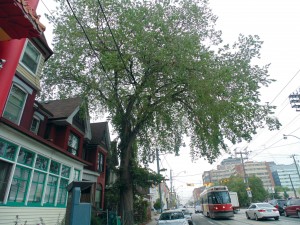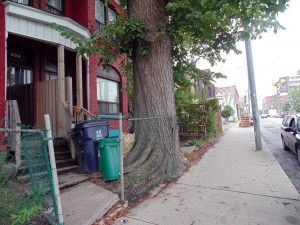A tree that keeps fighting back

This elm, located on Bathurst Street just south of Dundas Street, thrives in the urban landscape against all odds and despite the continued presence of Dutch elm disease. Brian Burchell, Gleaner News
By Alfred Holden,
Given up for lost, great elms soldier on. Extinction was predicted. I remember the news stories around 1970, so prone were the trees to deadly Dutch elm disease, which is still very much with us. But if you believe in evolution, or if you don’t, pull up a chair. Here’s a case study, survival of the fittest, of resilience in crisis, of biology pulling the rabbit out of the hat.

A collar of concrete and the assault of road salt in winter does nothing to deter this elm’s growth. Brian Burchell, Gleaner News
I have long admired this particular tree, a feral American elm that thrives in Toronto’s urban jungle on Bathurst Street, west side south of Dundas. Look around it; this tree speaks to the American elm’s tremendous powers. Neither salt, nor cement, nor hydro wires, nor a competing forest of recycling bins, nor the scourge of Dutch elm disease can keep the elm from growing tall.
On St. George Street, where I live, three or four American elms have outlived almost all the Norway maples, several of the silver maples, and the lindens. In my 33 years living there, the elms have gotten bigger, and not one mature example has died. When I was a boy in Ottawa, the elms were falling all around us (actually, elms seldom fall, their wood is very tough, they had to be cut down and since these are huge trees it was quite an affair). A future for them was hard to fathom. The fungus was accidentally imported from Asia on lumber, and the North American trees did not have the resistance of the Asian varieties. I have written, or assigned, quite a few news stories on this favourite topic for Sarah Barmak, who wrote up the Humewood elm for The Toronto Star.
One of the elm’s greatest friends is Martin Hubbes, a former U of T forestry professor who has schemed to biologically undermine the fungus that kills the trees. He has had mixed success, but all along has pointed out the elm’s persistence and discovered a multitude of ways the tree itself keeps fighting back. (“It’s maybe because they do kung fu,” my spouse pipes up, looking over my shoulder.) Hubbes does deep biology and chemistry; years ago I tried to explain it for readers in a piece in U of T’s Bulletin. One helpful thing the elm does is produce seeds at a young age, and while many trees die young, some don’t. What do you think is happening?
Hubbes pointed out to me that other than Dutch elm disease and very old age, not much kills an elm. They are the perfect urban tree, “elegant and adaptable”, strong as steel, big (giants) but well-behaved, writes Joseph Campanella in his book about the elm, Republic of Shade. Elms thrive to hugeness in unlikely places – not just in Toronto concrete but well north and south of their natural habitats, for instance as still-viable shade trees in deep-freezer prairie cities and in Florida.
When Ottawa’s elms were dying and being cut down, I watched the massacre walking to and from school – on elm-lined Clemow, around our house at Renfrew Avenue and Percy Street, along the parkways. I’d stop at the stumps and count rings. The stumps were four, five, eight feet across, and oozed smelly liquid. Brown streaks of the fungus that caused death could be seen. In the guts and the glory it was the turf version of coming across a dead whale on the beach.
When counting, what was impressive was not the number of rings but the width of them, one or two inches a year. Staggering production of hard matter through mere photosynthesis. As a boy I transplanted one, dug up in a back lane which eventually succumbed, but until then grew shockingly faster than I did. The National Capital Commission, against all advice, continued planting elms, and these count among Ottawa’s survivors today.
Campanella argues too many were planted in North American cities, and that this contributed to their fall, as the fungus, carried on the feet of bark beetles, zoomed from tree to tree. With fewer trees around today, he suggests, the disease hasn’t the hosts it needs to keep killing, hence the survivors. Hubbes might disagree – as I recall he did – pointing out that against all odds, and below the radar, the elm remains one of the most common trees on the landscape, found in numbers in every country hedgerow and neglected urban corner. The young trees quickly make seeds and keep the gene pool vigorous. Various cultivars, real elms that seem to resist, have been found. Hubbes has sought means to empower the trees’ existing, considerable capacity to fight back. As well the seeds of hardy survivors like the one on Bathurst Street (one of many such in Toronto) are blowing in the wind.
Some species planted to replace the elm, such as the ash, have been hit by their own pests, but have not responded with the elm’s resilience. Various scourges are creeping up on oaks, hemlocks, and other grand old types. You could make a doomsday movie. The plot: the elm would be the last one standing. Biologically, it’s got the stuff.
